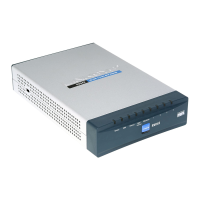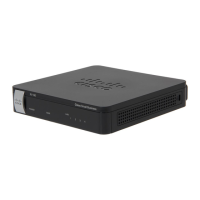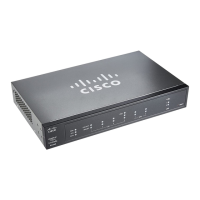Chapter 4
Advanced Configuration
33
10/100 16-Port VPN Router
Port Packet Error Count The number of packet errors is
displayed.
To update the on-screen information, click Refresh.
Firewall > General
Enable or disable a variety of firewall, security, and web
features.
Firewall > General
General
Firewall The firewall is enabled by default. If you disable
it, then the SPI, DoS, and Block WAN Request features,
Access Rules, and Content Filters will also be disabled, and
the Remote Management feature will be enabled.
SPI (Stateful Packet Inspection) This option is enabled
by default. The Router’s firewall uses Stateful Packet
Inspection to review the information that passes through
the firewall. It inspects all packets based on the established
connection, prior to passing the packets for processing
through a higher protocol layer.
DoS (Denial of Service) This option is enabled by default.
It protects internal networks from Internet attacks, such
as SYN Flooding, Smurf, LAND, Ping of Death, IP Spoofing,
and reassembly attacks.
Block WAN Request This option is enabled by default.
Using this feature, the Router drops both unaccepted TCP
request and ICMP packets from the WAN side. Hackers will
not find the Router by pinging the WAN IP address.
Remote Management This option is disabled by
default. If you want to manage the Router through a WAN
connection, first change the password on the Setup >
Password screen (this prevents any user from accessing
the Router with the default password). Then select Enable
for the Remote Management setting, and enter the port
number (port 80, the default, or 8080 is usually used).
NOTE: If the Remote Management feature on
the Firewall > General screen has been enabled,
then users with administrative privileges can
remotely access the web-based utility. Use
http://<WAN IP address of the Router>, or
use https://<WAN IP address of the Router> if
you have enabled the HTTPS feature.
HTTPS HTTPS is a secured HTTP session. If Remote
Management is enabled, HTTPS is enabled by default.
NOTE: If you disable the HTTPS feature, then
you also disable the Linksys QuickVPN service
on the Router.
Multicast Pass Through This option is disabled by default.
IP multicasting occurs when a single data transmission
is sent to multiple recipients at the same time. Using
this feature, the Router allows IP multicast packets to be
forwarded to the appropriate LAN devices. Multicast Pass
Through is used for Internet games, videoconferencing,
and multimedia applications.
Restrict WEB Features
Block Select the filters you want to use.
Java • Java is a programming language for websites. If
you deny Java applets, you run the risk of losing access
to Internet sites created using this programming
language. To block Java applets, select Java.
Cookies • A cookie is data stored on your PC and used
by Internet sites when you interact with them. To block
cookies, select Cookies.
ActiveX • ActiveX is a programming language for
websites. If you deny ActiveX, you run the risk of losing
access to Internet sites created using this programming
language. To block ActiveX, select ActiveX.
Access to HTTP Proxy Servers • Use of WAN proxy
servers may compromise the Router’s security. If you
block access to HTTP proxy servers, then you block
access to WAN proxy servers. To block access, select
Access to HTTP Proxy Servers.
Don’t block Java/ActiveX/Cookies/Proxy to Trusted
Domains To keep trusted sites unblocked, select this
option.
Add Enter the domain you want to block.

